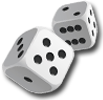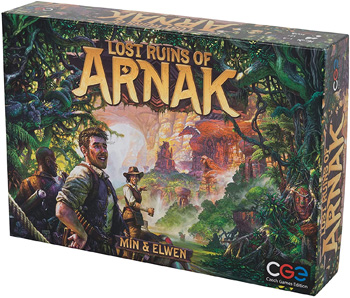



play board games
Board game reviews, strategy tips & session reports
Lost Ruins of Arnak Board Game Review
 Stats:
Stats:
No. of players: 1-4
Amount of time to play: 45-120 min
Age requirements: 12+
Set-up time: 5 min
Lost Ruins of Arnak is a deck-building, worker placement board game. You use cards to place workers or for other effects to explore to help you explore the island and score VPs.
Lost Ruins of Arnak Rules Description:
Lost Ruins of Arnak ends after five rounds, but players all start with the same starter deck and two workers. You start with different resources based on turn order.
On your turn you may take one main action and as many free actions as you like. Play continues clockwise until you cannot or do not want to take anymore actions. At that point, the round is over.
Cards may be used for their main ability or for their travel icon. You need travel icons to place your workers on the board. The specific travel icon(s) needed depend on where they are on the board. With better spots requiring more icons.
Travelling to undiscovered spots requires travel icons and compass tokens. You take the idol token there and gets its bonus immediately. Idols are worth 3 VPs at the end of the game. Exploring the new site awaken its guardian that can be overcome for a one-time bonus and VPs.
There are always six cards available to buy. Buying an artifact lets you use its ability immediately. But when drawn later you need to use a scribe token to activate its effects. When bought, item cards go to the bottom of your draw deck.
It costs you resources to move up the research track. You have a magnifying glass and book token. You may never advance the book token above the magnifying glass. If you get to a space on the research track first, you may get a one-time bonus. And getting to the top lets you explore the lost temple.
After all players pass you take back your workers. Any workers on spaces with a guardian cause you to take one fear card. These are each worth a negative point at the end of the game. You may exile fear (or other) cards using certain cards or spaces. Next you discard any cards you want to your play area. Any cards in your play area are shuffled and placed at the bottom of your deck. Then you draw back to five cards.
The game ends after five rounds and you total VPs for your place on the research track, temple exploration tiles, idols, guardians you overcame, and the tools and artifacts you bought. Once you subtract VPs for any fear cards in your deck you compare the totals and the player with the most VPs wins. Ties go to the first player to reach the lost temple. If no one go there, then the player with the most research VPs wins.
Quick Review of Lost Ruins of Arnak:
Lost Ruins of Arnak combines the worker placement and deck-building mechanics into a fun thematic board game. It is a great medium weight game to play with gamers that have played a few gateway games and are ready for more.
The components for this game are very nice. The art matches the theme, and the token and chits are high quality. There is some iconography to learn but it is straightforward, and the rules contain card clarifications if needed. The rules are well written and organized with examples.
While not really doing something brand new, Lost Ruins of Arnak does a great job combining two of my favorite mechanics. Since you are limited to just two workers deck-building to get more resources is important.
As you build your deck and better spaces on the board are discovered, you can get more done. I like how the rounds progress the further into the game you go. It really feels like you are ramping up and building an engine so you can do more each round.
I did not mention resource management as one of the core mechanics, but I should. You need to make sure you get the resources you need to overcome guardians and travel to the better spaces. But you really need to pay attention to what you need for the research track. There are many ways to score VPs in Lost Ruins of Arnak, but if you ignore the research track you will probably not win.
This game’s theme comes through in a lot of its small mechanics. When you buy an item, it takes time to arrive on the island. So bought item cards go on the bottom of your draw deck. Also as the rounds progress there more artifact cards available in the market to represent you discovering more of these as you explore the island. And the research token advancement restriction represents you first studying (the magnifying glass) and then writing your findings down (the book).
I have not tried it, but the game also has a solo mode that I have heard good things about. You can even play a solo campaign for details check out this website.
If you are looking for a fun, thematic, medium-weight board game, pick up Lost Ruins of Arnak. It is enjoyable for a range of ages and both new and experienced gamers.
Score and synopsis: (Click here for an explanation of these review categories.)
Strategy 4 out of 6
Luck 4 out of 6
Player Interaction 5 of 6
Replay Value 5 out of 6
Complexity 5 out of 6
Fun 5 out of 6
Overall 5 out of 6

Leave a Reply